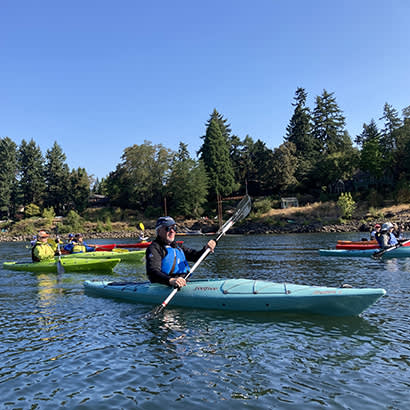
For an enhanced digital experience, read this story in the ezine.
After stepping into a kayak, pushing off the bank and taking that first stroke of the paddle in the water, it’s easy to understand why anyone can get hooked on human-powered water sports. Paddling and playing in the water bring people and nature together for a blend of relaxation and exhilaration. There are so many good reasons to be on the water: exercise, socialization, appreciation of surroundings and enjoyment.
As park and recreation professionals, we examine ways to promote healthy living, connect with others and ensure continued awareness for conservation of natural areas. Providing access to water sports is a perfect recipe for all those endeavors. The question is: How do we make it desirable for older adults to access lakes, rivers and oceans to get their paddle on?
Lake Oswego Parks and Recreation (LOPR; Oregon) identified and addressed some of the key difficulties in accessing water sports for older adults. Getting into and out of a kayak or standing up on a paddleboard can be intimidating for anyone looking to learn the skills of these popular activities. For people ages 50 and older who don’t know where to go to access the water, have no equipment or haven’t ever paddled before, it can be doubly challenging. The main goal for the design of LOPR 50+ Kayak Trips is to remove barriers of self-consciousness and fear of failure and allow participants to have fun, stay safe, and build skills and confidence while exploring a river, lake or ocean.
Providing water sports in a safe, non-threatening environment for older adults is key to increasing participation. A 50+ Kayak Tour, planned for fall while the water depth is lower, the water temperature is warmer and there is less boating traffic, helps keep the water calmer for safer paddling. Adding the familiarity of a local recreation center to meet and receive transportation by bus to a local waterfront launch, along with the provision of equipment and an easy, no-pressure lesson by assistants and instructors, gives patrons an opportunity to join their peers — thereby reducing anxiety and encouraging participation.
During the lesson, safety precautions are repeated so everyone can hear and understand. Extra time is given to ask questions on shore, and inflatable and hard-shell equipment are available. These options enable participants to try out different equipment and find their preferences. Skills, like getting into and out of the kayak and paddling, are taught verbally first, then demonstrated in a fashion that proves grace of technique is not necessary and allows extra time to practice on land and water.
Humor and patience are vital to a successful experience. After the paddle, ensure there is plenty of information about rentals and other put-in/take-out paddle spots. Allow time for questions and photos. One group’s experience in and around accessible water areas geared toward a population of people ages 50 and older may lead someone to a new love for water sports and a life-changing journey along the lazy river.
Jan Wirtz is Deputy Director at Lake Oswego Parks and Recreation.

